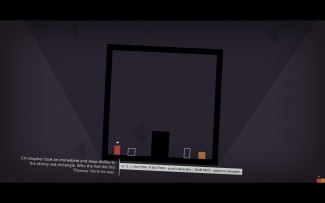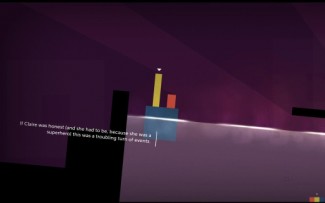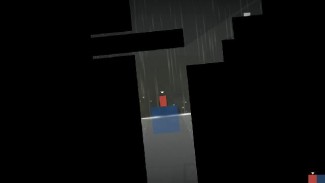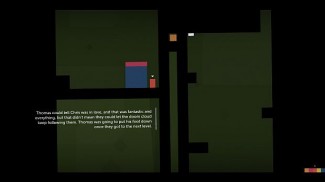Grapple Dog
LQ: 9.0
Recommended Age: 5+
Skills Used: Self-Awareness, Working Memory, Reading

Google Play / iTunes / Steam
Thomas Was Alone is a puzzle-platformer in which players take control of rectangles of different sizes, shapes, and abilities. These rectangles are revealed to be newly sentient AIs escaping a computer system. Players first meet Thomas, a red rectangle, and they slowly learn the mechanics of the game through Thomas’ growth and developing self-awareness as he adapts to levels of increasing complexity. But even as the AI begins to understand himself and his surroundings, he longs for the connectedness that will allow him to share the experience with others. As more AIs join the team with their differing personalities and abilities, they must work together to solve the mystery of their origins and escape their dark surroundings. With simple striking graphics, relaxing music, well-done physics, and amusing writing and narration, Thomas Was Alone is a game older kids will find totally absorbing. Due to a couple incidents of mild language and euphemisms, LW4K recommends this game for kids 12 and older.
Teachers: check out the classroom guide!
Adapting and adjusting to changing conditions and expectations.
 The game play in Thomas Was Alone is simple, its environments are stark, and there is no inventory. Players must make the best of what they have: a simple jump mechanic and, as the game progresses, the additional abilities of the other AIs. Not only do levels change with the addition of obstacles and pitfalls, but as new AIs follow Thomas, the team dynamic changes too, and players watch these rectangles learn from each other and rely on each other. The game encourages gratitude for the resources one has, as well as practice in cognitive reframing and the resilience that comes from recognizing obstacles, attempting to overcome them, and relying on the hope that this work is not all in vain.
The game play in Thomas Was Alone is simple, its environments are stark, and there is no inventory. Players must make the best of what they have: a simple jump mechanic and, as the game progresses, the additional abilities of the other AIs. Not only do levels change with the addition of obstacles and pitfalls, but as new AIs follow Thomas, the team dynamic changes too, and players watch these rectangles learn from each other and rely on each other. The game encourages gratitude for the resources one has, as well as practice in cognitive reframing and the resilience that comes from recognizing obstacles, attempting to overcome them, and relying on the hope that this work is not all in vain.
Understanding our own actions, thoughts and feelings and empathizing with others.
 Thomas Was Alone calls upon multiple aspects of a player’s self-awareness. The stream-of-consciousness narrative that makes the game so immersive serves a purpose beyond just to amuse; it can provide a player with models of healthy self-talk and metacognition. Beyond self-assessment, players will also get lessons in social awareness and empathy. The connectedness Thomas longs for brings complications as new AIs join the group, yet with each addition everyone on the team also gains purpose. For instance, Thomas’ height doesn’t seem that important until the vertically challenged Christopher needs a leg up, and Christopher can fit into spaces Thomas cannot. The rectangular AIs in Thomas Was Alone grow to really care about one another, and players will care for them too.
Thomas Was Alone calls upon multiple aspects of a player’s self-awareness. The stream-of-consciousness narrative that makes the game so immersive serves a purpose beyond just to amuse; it can provide a player with models of healthy self-talk and metacognition. Beyond self-assessment, players will also get lessons in social awareness and empathy. The connectedness Thomas longs for brings complications as new AIs join the group, yet with each addition everyone on the team also gains purpose. For instance, Thomas’ height doesn’t seem that important until the vertically challenged Christopher needs a leg up, and Christopher can fit into spaces Thomas cannot. The rectangular AIs in Thomas Was Alone grow to really care about one another, and players will care for them too.
Use this Play Together guide to learn how you can help your child turn Thomas Was Alone play time into a positive learning and relationship-building experience. To learn more about why playing games with your children is so important, check out our Science of Play page.
Take a minute to talk with your child about how the Flexibility and Self-Awareness thinking skills work, and why they are important for success in school and at home.
 Set Gameplay Goals
Set Gameplay GoalsThomas Was Alone is a single player game, but its short episodic levels and chapters make it easy to take turns playing side-by-side with your child.
Gameplay Goals:
After you've found Claire, take a moment to discuss with your child the importance of the thinking skills at play in Thomas Was Alone.
How do the characters your child has met in the game so far, and their internal dialogues, differ? How do the AIs work together despite these differences? Are there things one AI is good at that another is not? How do the AIs compliment each other? What kind of strategies did your child use as more AIs were added to the team? Can these strategies be translated to academic or social situations?
How does social flexibility compare to the flexibility practiced in order to get past a particularly difficult in-game obstacle? Is it difficult to work through the game with so few mechanics, or does the game give players just enough to get by?
Are there times when your child’s self-talk isn’t so constructive (like Christopher’s, for example)? Does the game remind them of real-life people and relationships? Is there someone who is difficult to get along with who still has admirable qualities and talents? Are there people and things they take for granted sometimes? How does the game make them think about what they are thankful for?
Our Make it Work activities are designed to transform your child’s gameplay to real-world improvements in thinking and academic skills. If you’re just getting started with LearningWorks for Kids, we suggest you try them all to find which are the best for you and your child.
 Read over the pages for the flexibility and self-awareness thinking skills. Then take some time to introduce these skills to your child. Explain to your child that:
Read over the pages for the flexibility and self-awareness thinking skills. Then take some time to introduce these skills to your child. Explain to your child that:
Try teaching your child how to use common household items in different and unusual ways. Ask your child to come up with ten ways to use a fork, book, pen, or piece of clothing and discuss how being flexible can help to solve problems. Flexible problem solving often uses the materials on hand in the house to fill a variety of different purposes. Talk to your child about ways to apply this approach in her own life.
 Self-Awareness Activity
Self-Awareness ActivityTalk about how others might be thinking or feeling. Discuss your own experience while involved in an activity with your child, ask about her thoughts or feelings and compare impressions. Use everyday circumstances to motivate your child to consider how other kids might be feeling in situations such as before a recital, staying home alone for the first time, or losing a game. Find similar chances to discuss the feelings of others while watching sports on television, learning about an accident or seeing a classmate receive an award for an accomplishment.
All membership plans come with full access to our entire suite of tools learning guides, and resources. Here are a few of the ones we think you’ll like the most: